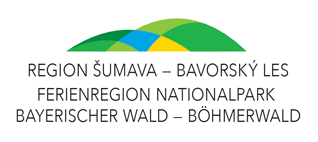2 – The Former Bird Reservoir
The former reservoir at the confluence of Ptačí and Mokrůvka, lying in 1140 meters above sea level, served to catch water for the purposes of timber rafting. During it, the water from it was let out into the Modrava stream. The wave of the let out water then carried the logs to the needle dam below Modrava. The reservoir was able to hold up to 1000 m3 of water.
Today it is an integral part of the unique technical work – the Vchynice-Tetov channel, built between 1799 and 1801 to transport timber in otherwise inaccessible parts of Šumava. It is a part of eight similar reservoirs and protected as a historic sight since 2013. The reservoir has been dry since the 1950s, its bottom is heavily waterlogged, covered in grass and short spruces. In the crown of the dam leads a solidified path from Filipova Huť to Březník. In the middle of the dam is a recently repaired drain.
The reservoir has a vaguely triangular shape, its straight dam is placed on its northern side and is 65 meters long. The artificially heaped rampart is trapezoidal in shape. Aproximatelly in the middle of it is a drain. The eastern side of the rampart still has an outlet leading into the stream.
The reservoir is located in the core habitat of the western capercaillie and is a part of an area left to self-development.
By it, there is a highland peatbog covered by mountain pine, taking up the area of 58 ha and with maximum depth reaching three and a half meters. The reserve of peat is assumed to be around 290 thousand cubic meters.
The bird stream springs up on the western slope of Black mountain in 1220 meters above sea level. It flows through Bishops’ moor all the way to the former Bird Reservoir. There it connects with the Mokrůvka stream, which springs up on the northern slope between Malá Mokrůvka (1330 m) and Mrtvý vrch (1254 m). It then continues in a northwestern direction to the confluence with Modrava stream, which is the crenon of the Vydra river. The bird stream became known for a blockade with which eco activists fought against the cutting down of bark beetle infested trees. According to the organisers, the administration of the NP Šumava did not have the necessary granted exception to this action.
Today it is an integral part of the unique technical work – the Vchynice-Tetov channel, built between 1799 and 1801 to transport timber in otherwise inaccessible parts of Šumava. It is a part of eight similar reservoirs and protected as a historic sight since 2013. The reservoir has been dry since the 1950s, its bottom is heavily waterlogged, covered in grass and short spruces. In the crown of the dam leads a solidified path from Filipova Huť to Březník. In the middle of the dam is a recently repaired drain.
The reservoir has a vaguely triangular shape, its straight dam is placed on its northern side and is 65 meters long. The artificially heaped rampart is trapezoidal in shape. Aproximatelly in the middle of it is a drain. The eastern side of the rampart still has an outlet leading into the stream.
The reservoir is located in the core habitat of the western capercaillie and is a part of an area left to self-development.
By it, there is a highland peatbog covered by mountain pine, taking up the area of 58 ha and with maximum depth reaching three and a half meters. The reserve of peat is assumed to be around 290 thousand cubic meters.
The bird stream springs up on the western slope of Black mountain in 1220 meters above sea level. It flows through Bishops’ moor all the way to the former Bird Reservoir. There it connects with the Mokrůvka stream, which springs up on the northern slope between Malá Mokrůvka (1330 m) and Mrtvý vrch (1254 m). It then continues in a northwestern direction to the confluence with Modrava stream, which is the crenon of the Vydra river. The bird stream became known for a blockade with which eco activists fought against the cutting down of bark beetle infested trees. According to the organisers, the administration of the NP Šumava did not have the necessary granted exception to this action.
